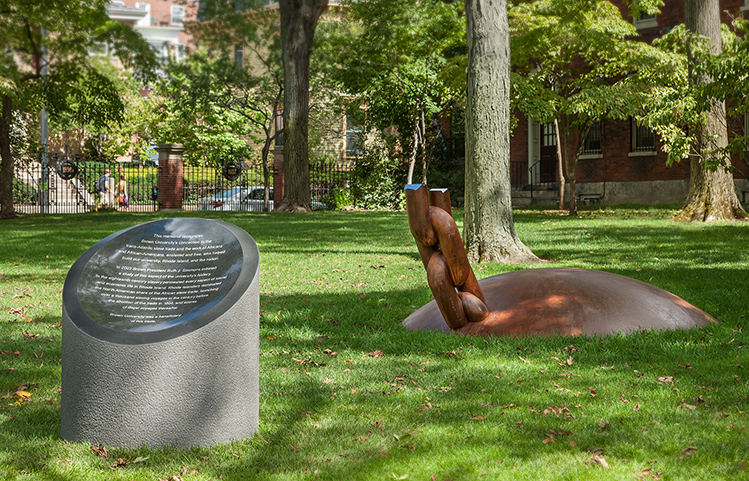Port marker to remember slavery underway in Providence
Earlier this week, the Rhode Island Middle Passage Ceremonies and Port Markers Project met with residents in Providence to discuss putting up a marker at a port that was used during the slave trade. The national organization was founded five years ago, and began work in...

The Slavery Memorial at Brown University, installed in 2014. Credit: Warren Jagger.
“When people ask me about monuments to enslavement, my general answer is: look around. Every beautiful building built in the 18th century was built not only by the hands of enslaved individuals but by the money the process created. The streets that are paved with cobblestone in Newport are paved from the money from the system of slavery. That’s not to say we don’t need explicit markers, but I see our memorials to the men, women, and children who were forced to work here everywhere I walk,” says Morgan Grefe, the Executive Director of the Rhode Island Historical Society.According to Grefe, Rhode Island was the leading slave trader out of all of the North American colonies. “Despite its small size, if you were on the west coast of Africa in the 1760’s and you see another American vessel, there is a 60% chance that it is from Rhode Island,” remarks Grefe. While many other colonies depended on agriculture, Rhode Island used its maritime power to make money. So more than any other state, Rhode Island produced ships and funded trips to Africa to capture people and sell them as slaves through the colonies. In her 11 years at the Historical Society, Grefe says she’s seen public interest in issues surrounding race grow, which she attributes in part to recent shootings in places like Ferguson bringing the issue into the spotlight. She also says that social media has brought the issue to many people’s attention by allowing them to read about other people’s experiences with race. Back in Rhode Island, volunteers are working on establishing explicit markers for ports used during the slave trade in Providence, Warren, Bristol, and Newport. Here in Providence, the port marker is still in its beginning stages. The Middle Passage Ceremonies and Port Markers Project had an open meeting on Monday night to launch the Providence project. They discussed what the marker should look like, where it should be, and how they should unveil it. Kugler was pleased with the energy Rhode Islanders brought to the project, coming in with concrete ideas and write ups for where they want the marker to be. When the Providence marker is unveiled, there will also be a ceremony educating the public on how Africans and their descendants were forced to help build this nation. “We’re trying to aim here to talk about both Rhode Island’s role as a global player in the transatlantic human trade while honoring the lives of those that survived and lived here, and how their descendants helped build this community,” says Kugler. Staff from the Rhode Island Historical Society are also working on the project’s education team to make sure the content of this ceremony is accurate. But Grefe says she hopes the information is accessible beyond just the ceremony: “We also want to make sure that this opportunity moves beyond a marker and can have some influence into education materials, so that classroom teachers, homeschoolers, people just with an internet connection can see how to teach this, learn about this in different ways.” Kugler says she knows that port markers won’t be the end of the conversation about slavery and its descendants, but she says she hopes it will help educate Rhode Islanders on the subject. “This is not the solution, this is not the last step, and it is by no means a finished conversation,” says Kugler. The Rhode Island Middle Passage Ceremonies and Port Markers Project is hoping to have its Providence marker up by the fall of next year.

